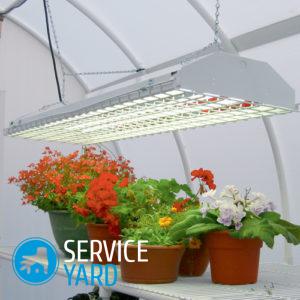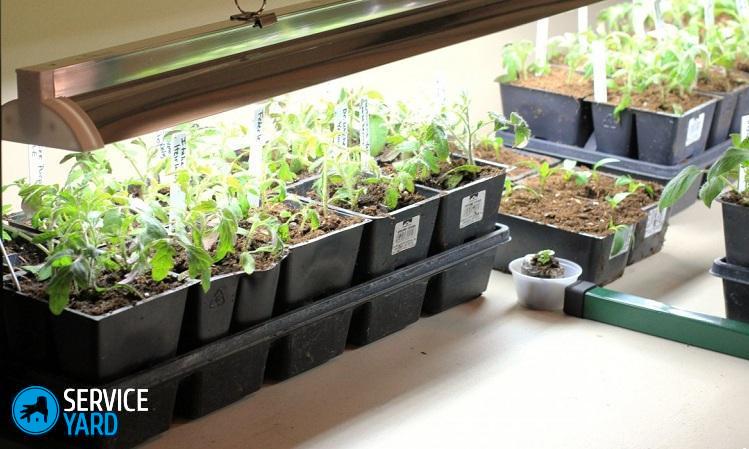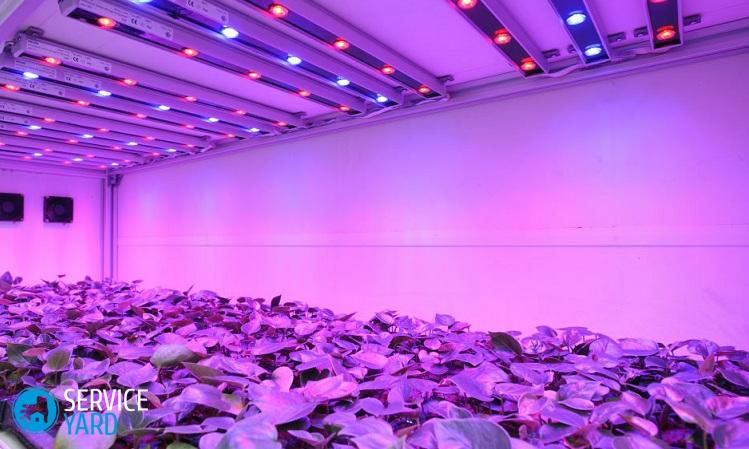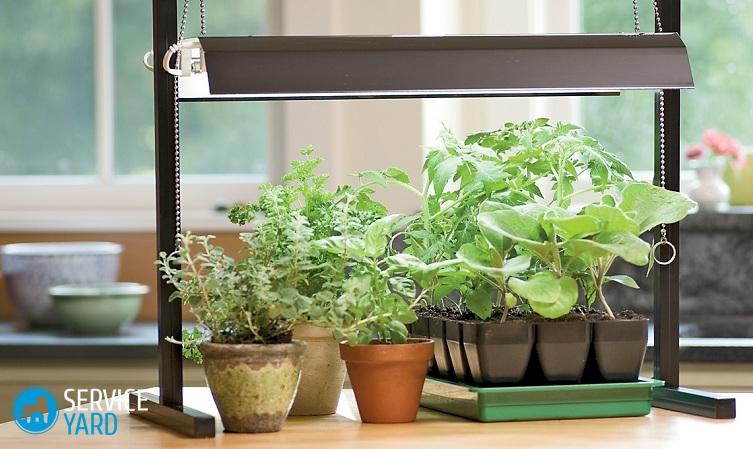DIY seedling illumination with LED lamps

Of course, all summer residents want seedlings to be already stronger by the time they land in the ground. But in this way we want to change the course of nature, because in spring a sunny day is much longer than in January-February. It’s not so difficult to create comfortable temperature conditions, observe the rules of watering, but you will have to try with lighting. Do-it-yourself lighting of seedlings with LED lamps is a task that is quite realistic to accomplish. When using additional lamps, you need to remember that not every light is useful to plants. We will tell you everything in order in this article so that the organization of lighting for seedlings is literate.
to contents ↑Backlight Organization Options
The most commonly used methods are:
- Illumination on a windowsill without lamps;
- Additional lighting with various types of lamps.
Each of them is distinguished by its advantages and disadvantages, we will consider them more carefully.
Backlight without lamps
To organize the lighting, it was enough simple construction of a cardboard box, which is placed on the windowsill. At the box, it is necessary to remove the sidewall and top, leaving only low sides. The whole structure must be glued with foil and installed behind the plants. When sunlight enters through the window, it falls onto the foil. Due to the reflection of sunlight from the foil, the cultures are highlighted from all sides.
Important! Such lighting of seedlings at home with their own hands is a very economical option, but at the same time quite effective. The main disadvantage is the lack of lighting on the north side or in cloudy weather. In this case, you can not do without lamps.
Backlight with lamps
In order for complete photosynthesis to take place, plants need the light of the sun. It consists of waves having different lengths and various colors. For example, due to the red light, the seed vegetation improves, it affects the germination, but blue and violet ensure that strong sprouts appear. In addition, plant growth depends on the intensity and duration of lighting. All this must be taken into account when choosing lamps for seedlings at home.
Classic incandescent lamp
In an attempt to save money, many people use ordinary tungsten filament lamps for backlighting. This process is not only ineffective, it does not bring any benefits. The fact is that the radiation in such luminaires becomes only five percent luminous flux, and the rest is the thermal component. In other words, heat is generated more from such a light source than light.
Important! A classic lamp does not have a radiation spectrum that suits plants. Burns may appear on the leaves, and the biomass dries.
Phytolamps
This backlight can be called perfect. With traditional artificial light sources they are distinguished by the generation of photons. In phytolamps it is not colored and narrow, but wide, more favorable for photosynthesis. In addition, UV and infrared radiation harmful to green cells does not occur.
Important! The design combines blue and red glow, which confirms the universality of such artificial light.
LED strip
In this semiconductor device, a distortion of the electrical voltage into the light occurs.LED lamps for lighting seedlings at home have several advantages:
- Profitability. Electricity consumption in such devices is eight times lower than in classic bulbs.
- Quick turn on. The glow will be even and without flicker.
- Longevity. The device can work up to 50,000 hours.
- Environmental friendliness. They do not need special disposal, the composition does not include harmful chemical elements.
Fluorescent lamps
Such a lamp is a gas-discharge mercury lighting device in which fluorescence is used for radiation. Thanks to mercury vapor, an electric current is excited in the gas and light is emitted in the ultraviolet range. All this leads to the glow of the phosphorus coating located inside.
Important! A fluorescent lamp for seedlings with your own hands is a very suitable option, since the energy consumption is minimal, heat radiation practically does not occur.
Metal Halide Sodium Lamps
These lamps have many advantages:
- High light output;
- A large set of popular temperatures;
- Wonderful color reproduction.
With the help of this highlighting, a positive effect is exerted on the root system, as a result of which a short internode and good branching develop.
to contents ↑Important! Such lamps are not recommended for use at the stage of flowering plants.
DIY lighting
Most often, lighting for seedlings at home is done by LEDs. Such lamps are characterized by low energy consumption, so they can be placed close to plants, without fear that they will get burns, and the soil will dry out.
The main advantages of DIY lighting:
- The most important spectra are combined - blue and red;
- The cost of LEDs is low, they quickly pay off;
- Electricity consumption is minimal;
- The design is easy to install and easy to operate.
To make a phytolamp, you must:
- Make a diagram.
- Prepare the necessary materials.
- Assemble the equipment.
The necessary materials are presented:
- Old energy saving light bulb;
- A piece of unilateral fiberglass;
- A set of radio components;
- LEDs: red, white and blue;
- Capacitor;
- Resistance.
To make the circuit:
- Cut a circle with a diameter of 3 cm from foil or textolite.
- Using nail polish, draw paths.
- We make a solvent for copper and put a board in it to clean the tracks.
- We drill small holes.
- Solder all the details.
To collect the lamp:
- We disassemble the old lamp and remove everything that is in it, except for the wires coming from the base.
- Solder the circuit to the wires.
Important! How to fix a lamp for seedlings - an individual solution for everyone. To save space, you can build racks. To make them, you can use a metal corner or a wooden beam treated with stain. In order to interconnect parts, use self-tapping screws or bolts.
The design of the shelves is very simple, they look like shelves in which there are hollow compartments for drawers. Experts recommend doing no more than three rows. Each of them uses its own lamp.
to contents ↑Stock footage
Each gardener chooses lamps for illumination on their own. Someone is delighted with the luminescent ones, but for some the best ones are LED ones. It is worthwhile to conduct a series of experiments and observe the plants, with what kind of lighting they will feel most comfortable. With practice, understanding of the best solution will come just for you.
- How to choose a vacuum cleaner taking into account the characteristics of the house and coatings?
- What to look for when choosing a water delivery
- How to quickly create comfort at home - tips for housewives
- How to choose the perfect TV - useful tips
- What to look for when choosing blinds
- What should be running shoes?
- What useful things can you buy in a hardware store
- Iphone 11 pro max review
- Than iPhone is better than Android smartphones






